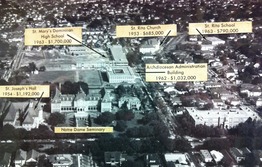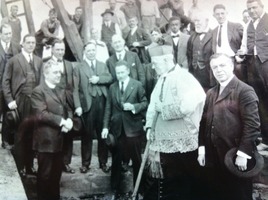
A platform that encourages healthy conversation, spiritual support, growth and fellowship

NOLACatholic Parenting Podcast
A natural progression of our weekly column in the Clarion Herald and blog

The best in Catholic news and inspiration - wherever you are!
Notre Dame Seminary site celebrates 100 years
-
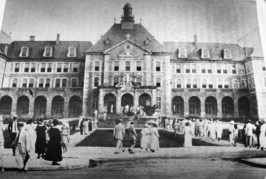
By Christine Bordelon
Clarion Herald
Notre Dame Seminary and Graduate School of Theology in New Orleans is celebrating its 100th anniversary at its South Carrollton Avenue campus this year, and there are several details in its history that will surprise many.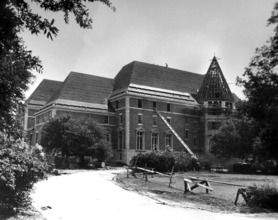
For one, the chateau-like edifice on South Carrollton Avenue that serves today as Notre Dame Seminary (NDS) wasn’t the first location of the seminary. In fact, it’s the 10th!The first seminary to serve Louisiana was actually in Missouri – St. Mary of the Barrens run by the Vincentian Fathers – when the central United States was part of the Louisiana Purchase, said Father Mark Raphael, Ph.D., and St. Louis King of France pastor, who first wrote a 200-page paperback as a seminarian in 1978 during the seminary’s 75th anniversary. Father Raphael published a second book on the seminary in 2016.
Other temporary seminary locations were upriver – the Ecclesiastical Diocesan Seminary of St. Vincent de Paul in Plattenville, Louisiana, until 1855 – and two tenures next to St. Stephen’s rectory on Napoleon Avenue and the Ursuline Convent site until 1881.
It took the vision of Archbishop John W. Shaw (1918-34) to build the permanent seminary we see now in the Carrollton area. He desired “to cultivate local vocations,” said Father Raphael.
Archbishop Shaw first had considered locating the seminary at the 20-acre site of the former White Castle Plantation near Donaldsonville or a second site on the river in Shrewsbury, near the current St. Agnes Church.
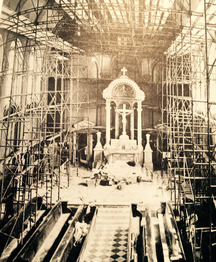 The current campus on Carrollton was acquired in 1910 through the efforts of Father John Francis Prim, pastor of Mater Dolorosa Church, who bought a 40-acre dairy farm. A capital campaign raised $1 million from some 50,000 subscribers by 1921.
The current campus on Carrollton was acquired in 1910 through the efforts of Father John Francis Prim, pastor of Mater Dolorosa Church, who bought a 40-acre dairy farm. A capital campaign raised $1 million from some 50,000 subscribers by 1921.General Allison Owen Sr. of Diboll and Owen Architects, a prominent Catholic layman, 4th Degree Knight of Columbus and Knight of St. Gregory, was commissioned to build the new seminary in the Beaux Arts style. That style was first brought to New Orleans when the Grunewald Hotel (now the Roosevelt) was redesigned in 1908.
The cornerstone was laid on May 7, 1922, and the seminary opened on Sept. 18, 1923, with approximately 25 students from the three Louisiana dioceses. The current archbishop’s residence next to the seminary was built in 1925.
From 25 to more than 1,000
Since the first graduating class of 25 seminarians from three Louisiana dioceses, nearly 1,000 seminarians have studied to become priests at Notre Dame. It is the second-largest theologate in the United States, Father Josh Rodrigue, the 17th rector, said. It is accredited by the Association of Theological Schools (ATS) and the Southern Association of Colleges and Schools Commission on Colleges (SACSCOC). Lay faithful can also earn advanced master’s degrees.Today, there are 134 seminarians from 24 dioceses and from the Diocese of Yendi in Ghana and the Archdiocese of Tororo in Uganda. Several orders, such as the Community of Jesus Crucified, the Benedictines and the Vietnamese Congregation of the Mother of the Redeemer (CRM) also send men to study here.
“The seminary is a way to assist the church worldwide,” Father Rodrigue said. “We’ve affected the Catholic faith in the southeast (U.S.). We have formed men to take care of the large flock in this area. … It’s a privilege we have to do this.”“Keeping that awareness – that the church is one sacramentally and spiritually can be lived out every day here in so many cultures and languages – is intentional,” Father Raphael added. “We have to be continually reminded of that.”
Improvements over years
Adapting to the new changes in the sixth edition of the Program of Priestly Formation (PPF) recently promulgated by the United States Conference of Catholic Bishops, Notre Dame Seminary is adapting by adding a “propaedeutic” year before men enter seminarian studies and creating a 3 1/2-year curriculum. This extra year of preparation permits “a jump start on the seminary,” Father Rodrigue said, offering more time to discern the priesthood and better “transition in human and spiritual formation” by living in community.“You see the men before they commit themselves, and you ease them and mold them into that way of life,” Father Rodrigue said. “They don’t have all the stressors of full seminary formation; they don’t have to worry about studies and papers. They can really focus on human and spiritual formation – growing in that relationship with the
Lord to really listen and grow in that friendship. That will be a foundation that is solid to build the rest on.”
Dr. Rebecca Maloney, academic dean for curriculum and instruction and director of institutional effectiveness at the seminary, sees the changes in the priestly formation model as positive for future priests.
“This will kick off our next 100 years by changing what we are doing,” Maloney said. “I believe it will only strengthen our guys and the whole formation process.”
The new students will have the time to learn about their Catholic faith and also parish life by having a half-year after being ordained a deacon and graduating from seminary to either work in a parish or take a language-immersion trip.
Father Rodrigue made an additional change in the schedule when he became rector in July. The daily horarium (schedule of daily prayer) now begins in the early morning, with prayer at 6:45 a.m. and Mass at 7 a.m. This allows an additional morning class period to be added before lunch and frees afternoon time for seminarians to break the fast pace and, sometimes, the anxiety of seminarian life.
“We’re trying to prevent spiritual and intellectual bulimia,” Father Rodrigue said. “I want time for the guys to absorb and take in their studies. I want to give them time to discern if the Lord is calling them to this vocation or not.
“I have found seminaries today have high anxiety. Just by changing the horarium has brought down that stress level a bit and gives them a little more freedom to ultimately discern, ‘This is something I also want, too.’ This helps ensure that solid formation and solid ‘yes’ to the church.”
Father Rodrigue said the free time in the afternoon gives the seminarians “better productivity and better ability to take in and let that knowledge be a part of them so they can share it with the people of God that they are entrusted to.”
The new schedule also has created time for fraternity among the men and faculty.
“The spirit of the guys in the house is really strong,” Father Raphael said. “With so much to discourage people of faith in the world, the spirit is strong. I think they are going to do great work. The recent improvements to the physical plant, along with ongoing refinements to the formation program, have positioned NDS for another century of service.”
To commemorate the 100th anniversary of the current NDS building, the seminary will hold its annual gala and auction March 25 at the seminary. It's a major fundraiser for the seminary. Deacon Carlo and Debbie Maniglia co-chaired the first gala, followed by Greg and Yvette LaCour and others who corralled a host of volunteers, including seminarians, and many community partners. Opening the seminary campus to the public has created strong support for the seminary and its mission.
"We always believe that there is no better mission to support the formation of future priests," Yvette Lacour, former seminary development director, said about the gala. "It’s such a blessing in so many people’s lives to be involved as a volunteer. ... For a lot of the volunteers, it became really personal because they were making connections with the seminarians and priests that worked there, and they became important to their family. "
A 100th anniversary celebration and dinner is scheduled for Sept. 14 (at a location to be determined). The 100th anniversary Mass will be celebrated Sept. 16 at St. Louis Cathedral.“The future looks hopeful,” Father Rodrigue said. “God has not stopped calling men to the priesthood. He hasn’t given up on us yet, so we are not going to give up on these men who are coming in. As long as dioceses, formation directors and parishes keep promoting vocations, we’ll have a place for seminarians to go … a place that can form shepherds to take care of the sheep. It won’t be an empty building, but a building filled with life, an atmosphere filled with joy and laughter.”
Father Rodrigue said there is “a joy about studying to be a priest.”
“We deal with serious things, but we don’t take ourselves seriously.,” he said. “We pray hard and play hard, and there is that time for fraternity.”
For details on the 100th anniversary events, call (504) 866-7426, ext. 374 or 375. Hard copies of Father Raphael’s 100th anniversary are available for $30 (or less if buying the Kindle version).





